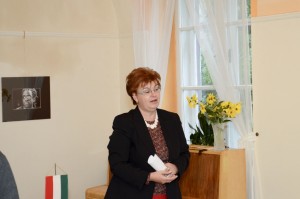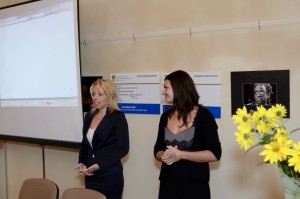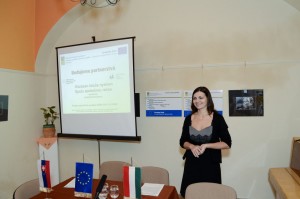The Hungarian Foundation for Information Society (HU) together with the Slovak Association for Common Goals (SK) elaborated the project named “Jointly for a common language” (Közösen közös nyelven – Spoločne spoločnou rečou) in the frameworks of a cross-border cooperation and were awarded a non-refundable 146 083 euro funding.
On Thursday, 27 September 2013, the aim of the program presented for the entrepreneurs and all interested parties in Csemadok Gallery in Komarno is to support SMEs near the border by a free service package and information system that can contribute to the development of their venture. First, the project manager of the program leading partner, the Foundation for Information Society, Marianna Török introduced the NGO. She said that “where idea becomes reality” is their guiding slogan and accordingly they carry out research and educational activities, they develop softwares based on the Hungarian and international market requirements as well as they work on projects.
Following this, the Director of the Slovak Association for Common Goals (created in 2001), Erzsébet Pogány described the goals and achievements of the Association. She emphasized that the alliance of legal entities controlled by her are striving for effective partnerships between various institutions of Slovakia and Hungary. The local Csemadok president, László Stubendek being the host of the event greeted the participants and underlined the significance of cross-border cooperation in the territory of culture.
Subsequently, Marianna Török together with the Slovak project manager, Kata Lelkes, delivered an interactive report on the project. They were speaking about the details of the project and provided practical guidance for the participants. We have learned that their experts have established a bilingual, electronic, video-based, text containing teaching platform (an eLearning system) that can also be used by hearing impaired. On the web page http://www.husk.infota.org, there are numerous short teaching materials that are permanently updated depending on the change of the legal regulations. They include entrepreneurial, financial, public procurement and call-writing information characteristic on both countries as well as country specific tax related teaching materials. They can be beneficial specifying practical assistance for the SMEs operating in any side of the border or for those who want to start their activities on the other side of the border and they can make their registration free.
A partner searching and project idea sharing data base www.husk.info-net.sk enabling registered users to find partners from the region for their projects or for contributing to national or EU funded calls are also integral parts of the project. At the presentation, it was mentioned that 1300 organisations had registered by then which – taking an average of 10 person/company – means 13 thousand users. The bilateral cooperation can start on 1 October. The project managers stated that by the help of their program, the entrepreneurs can spare the fees of expensive courses and publicity surfaces that would otherwise ensure their economic competitiveness. Meanwhile, they receive help to overcome the often occurring language difficulties as well as to thoroughly learn the differences of legal regulations on the two sides of the border. The joint project results in the establishment of new jobs, thus increasing the inhabitants’ life standard and gradually the borderline region can start to flourish. Kata Lelkes said that by the help of the experts, namely Foundation Director Ferenc Kiss as well as István Szanyi and Zsanett Benkő from Hungary and Gergely Molnár from Slovakia the developed teaching materials tried to be lifelike and disseminated to the interested people in the most effective way possible.  (Slovak translations were made by Tamás Méri.) Between the teaching platform and the company database, interoperability is assured for those who have registered free in one of the platforms. There is also attention paid to the prudence of the system. Although the registered members can see other’s project ideas and can get in touch with their owners, idea stealing cannot be effected because of the installed security-protection measures. The entrepreneurs can comment on the published teaching materials and they can also put questions to the involved teachers, thus making the platform interactive.
(Slovak translations were made by Tamás Méri.) Between the teaching platform and the company database, interoperability is assured for those who have registered free in one of the platforms. There is also attention paid to the prudence of the system. Although the registered members can see other’s project ideas and can get in touch with their owners, idea stealing cannot be effected because of the installed security-protection measures. The entrepreneurs can comment on the published teaching materials and they can also put questions to the involved teachers, thus making the platform interactive.



